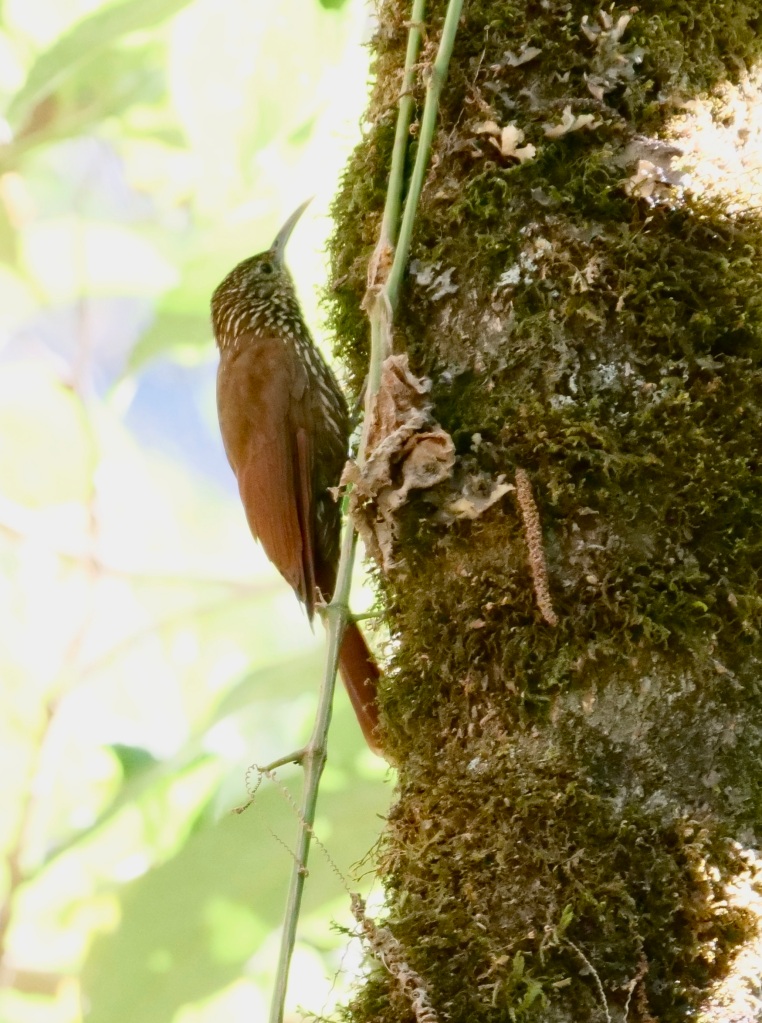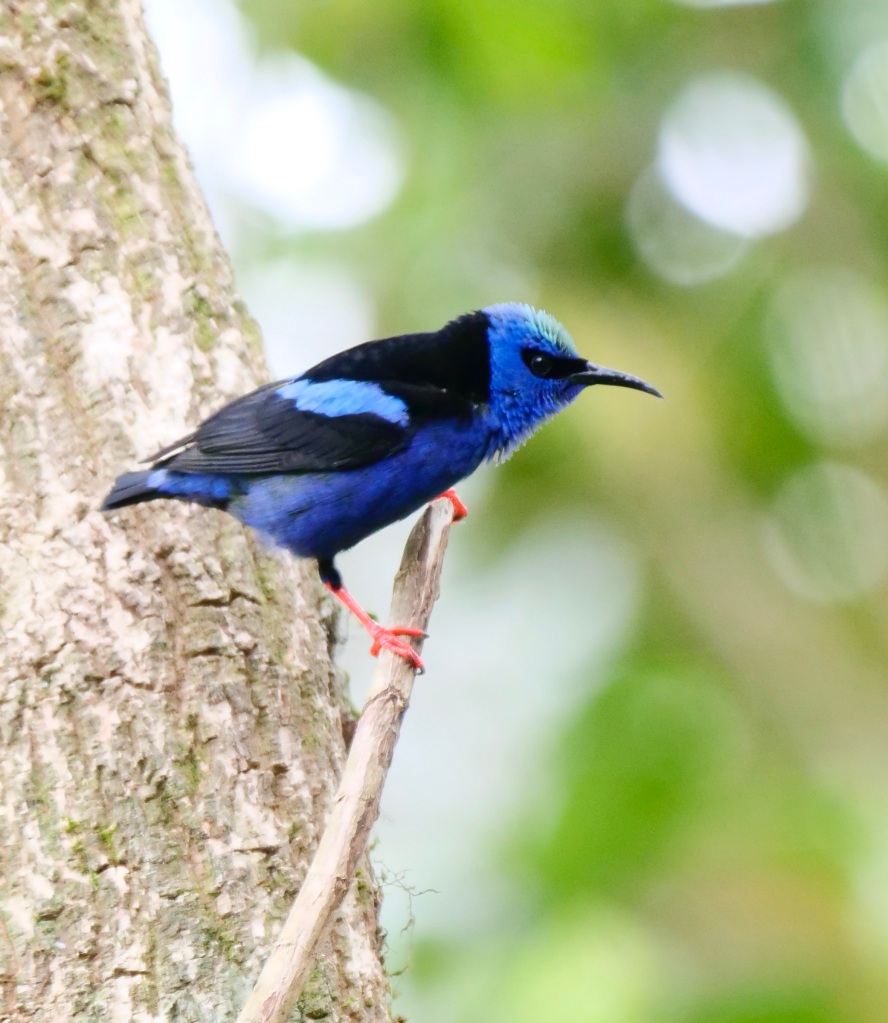My number 1000 was a Spot-crowned Woodcreeper seen on a mountain trail above the Savegre Lodge in Costa Rica. It was one of those strenuous days when our guide, Olivier Esquivel, was pushing Mel and me past our comfort zones. I was lagging behind on the narrow trail, just putting one step in front of the next, trying to keep up. Ollie and Mel waited patiently for me to catch up whenever they spotted a new bird. Now I’m glad they did. On March 14, 2022 I saw the woodcreeper.
Unfortunately I did not get a picture of the now famous bird, but did get a reasonable shot of his cousin, the Streak-headed. These birds are active, medium-sized woodcreepers usually found in the highland forests. As the name suggests you’ll discover it creeping up the trunks, poking its curved bill into the epiphytes looking for insects. I remember having a hard time spotting it, but finally got a reasonable binocular view with an assist from the laser pointer.
At the time we did not know my milestone had been reached. I knew we were closing in on it, but the tabulating was left to supper time, back at the lodge where the breathing was easier and we had a chance to reminisce about our day. Raised drinks and a small celebration occurred before we planned for the next day’s birding. Dinner tomorrow would be on me, as a gesture of appreciation for the guidance of Ollie and the encouragement from Mel.
Like many birders, I’m a little sheepish in admitting to the listing habit. Aren’t we suppose to revel in the mere observation of the avian world, noting bird behavior, mating and nesting habits, etc., while we explore their world in our backyard and abroad? But to my way of thinking record-keeping only enhances this pastime. Where did I first see that bird; how many birds have I seen in Florida this year; or what is my current yard or patch list? All of these are easily answered if you use eBird.
The world has seen some serious bird listers. John James Audubon’s four volume set, The Birds of America could be considered his list of 435 species. Three birders mentioned elsewhere in this blog are Phoebe Snetsinger, Kenn Kaufman, and Noah Strycker. In her incredible lifetime Phoebe created a world list of 8398 birds, but died doing it. Ken made a record 671 sightings for a 1973 record in North America when he was still a teenager. More recently in 2015 Noah, a 28 year-old, established a one year world mark of 6042. Now that’s a big year!
eBird is a database of the world’s bird observations submitted by amateurs and scientists alike. It was launched in 2002 by the Cornell Lab of Ornithology and the Audubon Society as a tool for tracking bird distribution and abundance. It accepts over 100 million bird sightings a year and makes all this data available to every user. You can easily determine what birds are being seen at virtually any location in the world on any given day, current or past. It is valuable for planning a birding trip or for chasing rarities. Your interface in the field is your smart phone. The program will even question you if you try to enter a bird not usually seen at your location. You can also add photos and birdsong recordings.
Better yet, the tool is a permanent record of all your personal observations that can be sorted by location or date. We birders are a somewhat obsessive compulsive group and this software nicely satisfies that exact character trait. If you are a new eBird user you can add all you old sightings and bring your life list up to date. All of this is free; one of the best bargains you’ll find.
I was an early convert to eBird and added my hand written data going back to 1983. The first entry was an Osprey seen at an old farmhouse we rented for a couple years on the Chesapeake Bay. My 500th bird was a Bewick’s Wren we ran across high in the Chiricahua Mountains of Arizona on November 30, 2016.
Now that the 1000 bird milestone has been reached and surpassed (the final count after Costa Rica is 1092), is 2000 in my sights? I don’t think so. Even though I’ve seen only ten percent of the world’s birds, adding to the list becomes harder and harder. To add more you must travel further from home and spend much more time and money. The legs and other body parts are no longer young. Oh, I’d like to take a trip to Patagonia; I’ve never laid eyes on a penguin. A trip to Alaska would be great, but I suspect New Guinea and Australia will be left for another life. For now I’m content to just return to my home patch and check up on the Cardinals and Jays. They’re pretty impressive themselves.









Congratulations on seeing your 1 000th bird species! This is a fantastic milestone to reach. You mentioning that you had not yet seen a penguin, and looking at the photographs of the beautiful birds in Costa Rica, makes me realise all over again how fortunate all of us are to enjoy our local species. After all, they are exotic to other people. We see penguins here and fellow bloggers express amazement at the ostriches we take for granted … as I am unlikely to travel beyond our borders much anymore, I am delighted to know that there are still hundreds of indigenous birds I have yet to see, or would love to see again.
LikeLiked by 1 person
I have a friend who keeps reminding me about the wonderful birds and other fauna in your neck of the woods. I didn’t mention it in the post, but Africa would also be on the radar still someday. Thanks once again for your comments and interest.
LikeLiked by 2 people
Reblogged this on maisysabredavid.
LikeLiked by 1 person
You honor me with this. Thanks.
LikeLiked by 1 person
Congratulations Steve!
LikeLiked by 2 people
Thanks. We’ll share a celebratory drink with you once we migrate north.
LikeLiked by 1 person